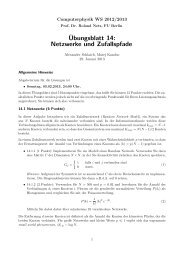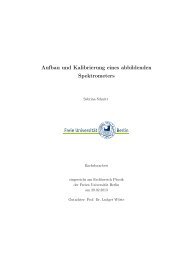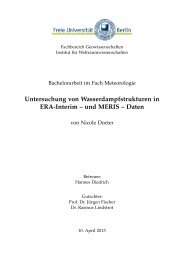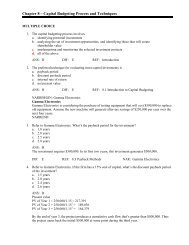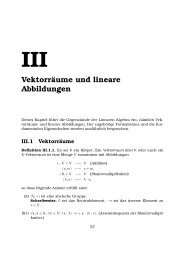General Self-Efficacy Scale - Userpage - Freie Universität Berlin
General Self-Efficacy Scale - Userpage - Freie Universität Berlin
General Self-Efficacy Scale - Userpage - Freie Universität Berlin
Create successful ePaper yourself
Turn your PDF publications into a flip-book with our unique Google optimized e-Paper software.
Everything you wanted to know about the<br />
<strong>General</strong> <strong>Self</strong>-<strong>Efficacy</strong> <strong>Scale</strong><br />
but were afraid to ask<br />
by Ralf Schwarzer, May 30, 2011<br />
The purpose of this FAQ is to assist the users of the scales published at the author's web pages<br />
http://www.ralfschwarzer.de/<br />
DOWNLOAD of PDFs: http://userpage.fu-berlin.de/~health/self/selfeff_public.htm<br />
Before attending to the questions below you might want to study our web pages. You might<br />
not have any questions after reading the web pages.<br />
Do I need permission to use the general perceived self-efficacy (GSE)<br />
scale?<br />
You do not need our explicit permission to utilize the scale in your research studies. We<br />
hereby grant you permission to use and reproduce the <strong>General</strong> <strong>Self</strong>-<strong>Efficacy</strong> <strong>Scale</strong> for your<br />
study, given that appropriate recognition of the source of the scale is made in the write-up of<br />
your study.<br />
The main source is:<br />
Schwarzer, R., & Jerusalem, M. (1995). <strong>General</strong>ized <strong>Self</strong>-<strong>Efficacy</strong> scale. In J. Weinman, S. Wright, &<br />
M. Johnston, Measures in health psychology: A user’s portfolio. Causal and control beliefs (pp. 35-<br />
37). Windsor, England: NFER-NELSON.<br />
An additional source for the German version is:<br />
Schwarzer, R., & Jerusalem, M. (Eds.). (1999). Skalen zur Erfassung von Lehrer- und<br />
Schülermerkmalen: Dokumentation der psychometrischen Verfahren im Rahmen der<br />
Wissenschaftlichen Begleitung des Modellversuchs Selbstwirksame Schulen. <strong>Berlin</strong>: <strong>Freie</strong><br />
<strong>Universität</strong> <strong>Berlin</strong>.<br />
I am not sure whether I want to measure general perceived self-efficacy<br />
(GSE) or specific health-related self-efficacy.<br />
You have to decide which one fits your research question. If you intend to predict a particular<br />
behavior you are better off with a specific scale. You might be best off by designing your own<br />
items, tailored to your study, such as:<br />
"I am certain that I can do ...xy..., even if ...zz ..." ( 1 2 3 4 ).<br />
Health-specific self-efficacy scales can be found at:<br />
http://userpage.fu-berlin.de/~health/healself.pdf<br />
For the English version of the teacher self-efficacy scale, see Schwarzer & Hallum (2008).<br />
If you are interested in other health behavior constructs, consult the NCI Health Behavior<br />
Constructs Website:
http://cancercontrol.cancer.gov/constructs<br />
What is the scoring procedure for the GSE?<br />
Add up all responses to a sum score. The range is from 10 to 40 points. Or use a mean score,<br />
such as:<br />
COMPUTE SEFF = Mean (SE1, SE2, SE3, SE4, SE5, SE6, SE7, SE8, SE9, SE10).<br />
In many samples the mean had been around 2.9<br />
Occasionally, someone will not respond to some of the items. What do you<br />
recommend to do with missing data?<br />
Our rule of thumb is to calculate a score as long as no more than three items on the ten-item<br />
scale are missing.<br />
In SPSS, this is done by :<br />
COMPUTE SEFF = Mean.7 (SE1, SE2, SE3, SE4, SE5, SE6, SE7, SE8, SE9, SE10).<br />
However, there are also other methods such as regression, hot deck, or multiple imputations<br />
techniques (ask your advisor).<br />
How can I categorize persons as being high or low self-efficacious?<br />
We do not endorse the view that people should be categorized this way. There is no cut-off<br />
score. One could, however, establish groups on the basis of the empirical distributions of a<br />
particular reference population.One could do a median split, which is to dichotomize the<br />
sample, for example, at the cut-off point of 30 (if this is near the median in your sample).<br />
Can I use some original data to compare with my own data?<br />
Yes, there is an international data set as an SPSS SAV file that includes about 18,000<br />
respondents. Available for free download at:<br />
http://www.fu-berlin.de/gesund/gesu_engl/world_zip.htm<br />
What are the psychometric characteristics of the GSE?<br />
It depends on the sample and the study context. There are more than 1,000 studies that have<br />
used the scales in many countries and languages<br />
There are currently scale versions adapted to 30 languages. See:<br />
http://userpage.fu-berlin.de/~health/selfscal.htm<br />
Updated psychometric findings have been published recently, for example, in:<br />
Scholz, U., Gutiérrez-Doña, B., Sud, S., & Schwarzer, R. (2002). Is general self-efficacy a universal<br />
construct? Psychometric findings from 25 countries. European Journal of Psychological<br />
Assessment, 18(3), 242-251.
Luszczynska, A., Gutiérrez-Doña, B., & Schwarzer, R. (2004). <strong>General</strong> self-efficacy in various<br />
domains of human functioning: Evidence from five countries. International Journal of<br />
Psychology.<br />
Can you tell me more about the validity of the GSE?<br />
Concurrent and Prognostic Validity<br />
of <strong>General</strong> Perceived <strong>Self</strong>-<strong>Efficacy</strong><br />
1989 1991<br />
Men Women Men Women<br />
Depression -.31 -.44 -.27 -.32<br />
Loneliness -.39 -.39 -.27 -.24<br />
Anxiety -.41 -.45 -.31 -.32<br />
Shyness -.47 -.47 -.33 -.29<br />
<strong>Self</strong>-Esteem .51 .59 .34 .40<br />
Optimism .48 .51 .20 .56<br />
Pessimism -.27 -.30 -.20 -.19<br />
Note. The correlations were derived from a sample of East German migrants in 1989 and 1991.<br />
n = 528 men and n = 380 women took part in the first wave of data collection, n = 122 men and n =<br />
102 women participated also at the second point in time.<br />
Correlations between <strong>Self</strong>-<strong>Efficacy</strong><br />
and Other Personality Traits<br />
Extraversion (FPI) .49<br />
Neuroticism -.42<br />
Extraversion (PDE) .64<br />
Failure or action orientation .43<br />
Decision or action orientation .49<br />
Action centering .15<br />
Hope for success .46<br />
Fear of failure -.45<br />
Note. The correlations were derived from a sample of N = 180 university students. All correlations are<br />
highly significant.<br />
What are the norms of the GSE?<br />
Heterogenous Adult<br />
Population<br />
T-Norms of the <strong>General</strong> Perceived <strong>Self</strong>-<strong>Efficacy</strong> <strong>Scale</strong><br />
High School Students US-American Adult<br />
Population
x T x T x T<br />
10 12 10 1<br />
11 14 11 3 11 14<br />
12 16 12 6 12 16<br />
13 18 13 8 13 18<br />
14 20 14 11 14 20<br />
15 22 15 13 15 22<br />
16 24 16 16 16 24<br />
17 26 17 19 17 26<br />
18 28 18 21 18 28<br />
19 30 19 24 19 30<br />
20 32 20 26 20 32<br />
21 34 21 29 21 33<br />
22 36 22 31 22 35<br />
23 38 23 34 23 37<br />
24 40 24 36 24 39<br />
25 42 25 39 25 41<br />
26 44 26 41 26 43<br />
27 46 27 44 27 45<br />
28 48 28 46 28 47<br />
29 49 29 49 29 49<br />
30 51 30 51 30 51<br />
31 53 31 54 31 53<br />
32 55 32 56 32 55<br />
33 57 33 59 33 57<br />
34 59 34 61 34 59<br />
35 61 35 64 35 61<br />
36 63 36 66 36 63<br />
37 65 37 69 37 65<br />
38 67 38 71 38 67<br />
39 69 39 74 39 69<br />
40 71 40 76 40 70<br />
Note.. Heterogenous Adult Population: The T-norms for the German version of this scale are based on<br />
a sample of N = 1,660 persons. The weighted mean was found to be 29.28, the weighted variance<br />
equalled 25.91.<br />
High School Students: These T-norms were derived from a sample of N = 3,494 German high school<br />
students (12 to 17 years old). In this sample the mean was found to be 29.60, standard deviation<br />
equalled 4.0.<br />
US-American Adult Polulation: These T-norms were derived from a sample of N = 1,594 US-<br />
American adults. In this sample the mean was found to be 29.48, standard deviation equalled 5.13.<br />
Gender was equally distributed, male 50.9%, female 49.1%.
Where can I read more about the scale and the research that has been<br />
conducted with it?<br />
Hinz A, Schumacher J, Albani C, Schmid G, & Brähler E (2006). Bevölkerungsrepräsentative<br />
Normierung der Skala zur Allgemeinen Selbstwirksamkeitserwartung. Diagnostica, 52(1), 26-<br />
32.<br />
Jerusalem, M., & Schwarzer, R. (1992). <strong>Self</strong>-efficacy as a resource factor in stress appraisal processes.<br />
In R. Schwarzer (Ed.), <strong>Self</strong>-efficacy: Thought control of action (pp. 195-213). Washington, DC:<br />
Hemisphere.<br />
Mittag, W., & Schwarzer, R. (1993). Interaction of employment status and self-efficacy on alcohol<br />
consumption: A two-wave study on stressful life transitions. Psychology & Health, 8, 77-87.<br />
Schwarzer, R. (1993). Measurement of perceived self-efficacy. Psychometric scales for cross-cultural<br />
research. <strong>Berlin</strong>, Germany: <strong>Freie</strong> <strong>Universität</strong> <strong>Berlin</strong> (no longer available)<br />
Schwarzer, R. (1994). Optimism, vulnerability, and self-beliefs as health-related cognitions:<br />
A systematic overview. Psychology & Health, 9, 161-180.<br />
Schwarzer, R., & Jerusalem, M. (1995). <strong>General</strong>ized <strong>Self</strong>-<strong>Efficacy</strong> scale. In J. Weinman, S. Wright, &<br />
M. Johnston, Measures in health psychology: A user’s portfolio. Causal and control beliefs (pp.<br />
35-37). Windsor, UK: NFER-NELSON.<br />
Zhang, J. X., & Schwarzer, R. (1995). Measuring optimistic self-beliefs: A Chinese adaptation of the<br />
<strong>General</strong> <strong>Self</strong>-<strong>Efficacy</strong> <strong>Scale</strong>. Psychologia: An International Journal of Psychology in the<br />
Orient, 38 (3), 174-181.<br />
Bäßler, J., & Schwarzer, R. (1996). Evaluación de la autoeficacia: Adaptación española de la escala de<br />
autoeficacia general [Measuring generalized self-beliefs: A Spanish adaptation of the <strong>General</strong><br />
<strong>Self</strong>-<strong>Efficacy</strong> scale]. Ansiedad y Estrés, 2 (1), 1-8.<br />
Schwarzer, R., & Fuchs, R. (1996). <strong>Self</strong>-efficacy and health behaviors. In M. Conner & P. Norman<br />
(Eds.), Predicting health behavior: Research and practice with social cognition models. (pp.<br />
163-196) Buckingham, UK: Open University Press.<br />
Schwarzer, R., Jerusalem, M., & Romek, V. (1996). Russian version of the <strong>General</strong> <strong>Self</strong>-<strong>Efficacy</strong><br />
<strong>Scale</strong>. Foreign Psychology (Moskow), 7, 71-77 [in Russian].<br />
Schwarzer, R., Bäßler, J., Kwiatek, P., Schröder, K., & Zhang, J. X. (1997). The assessment of<br />
optimistic self-beliefs: Comparison of the German, Spanish, and Chinese versions of the<br />
<strong>General</strong> <strong>Self</strong>-<strong>Efficacy</strong> <strong>Scale</strong>. Applied Psychology: An International Review, 46 (1), 69-88.<br />
Schwarzer, R., & Born, A. (1997). Optimistic self-beliefs: Assessment of general perceived selfefficacy<br />
in thirteen cultures. World Psychology, 3(1-2), 177-190.<br />
Schwarzer, R., Born, A., Iwawaki, S., Lee, Y.-M., Saito, E., & Yue, X. (1997). The assessment of<br />
optimistic self-beliefs: Comparison of the Chinese, Indonesian, Japanese and Korean versions of<br />
the <strong>General</strong> <strong>Self</strong>-<strong>Efficacy</strong> <strong>Scale</strong>. Psychologia: An International Journal of Psychology in the<br />
Orient, 40 (1), 1-13.<br />
Schwarzer, R., Mueller, J., & Greenglass, E. (1999). Assessment of perceived general self-efficacy on<br />
the Internet: Data collection in cyberspace. Anxiety, Stress, and Coping, 12, 145-161.<br />
Rimm, H., & Jerusalem, M. (1999). Adaptation and validation of an Estonian version of the <strong>General</strong><br />
<strong>Self</strong>-<strong>Efficacy</strong> <strong>Scale</strong> (ESES). Anxiety, Stress, and Coping, 12, 329-345.<br />
Schwarzer, R., & Jerusalem, M. (Eds.). (1999). Skalen zur Erfassung von Lehrer- und<br />
Schülermerkmalen: Dokumentation der psychometrischen Verfahren im Rahmen der<br />
Wissenschaftlichen Begleitung des Modellversuchs Selbstwirksame Schulen. <strong>Berlin</strong>: <strong>Freie</strong><br />
<strong>Universität</strong> <strong>Berlin</strong>.
Scholz, U., Gutiérrez-Doña, B., Sud, S., & Schwarzer, R. (2002). Is general self-efficacy a universal<br />
construct? Psychometric findings from 25 countries. European Journal of Psychological<br />
Assessment, 18(3), 242-251.<br />
Schwarzer, R. (2003). Selbstwirksamkeitserwartung – ein psychologisches Konstrukt für die<br />
pädagogische Praxis [<strong>Self</strong>-efficacy–A psychological construct for pedagogical practice]. In J.<br />
Koblitz & N. Posse (Hg.), Weiterbildung und Beratung – Zum Dialog von Theorie und Praxis.<br />
Festschrift für Christine Schwarzer (S. 125-152). <strong>Berlin</strong>: Logos Verlag.<br />
Schwarzer, R., & Jerusalem, M. (2004). <strong>General</strong> self-efficacy scale. In S. Salek (Ed.), Compendium of<br />
quality of life instruments (Vol. 6, Section 2A:1) [CD-ROM]. Cardiff, Wales: Centre for<br />
Socioeconomic Research, Cardiff University. Haslemere, England: Euromed Communications<br />
[CD-ROM publication, without page numbers].<br />
Schwarzer, R., & Schmitz, G. S. (2004). Perceived self-efficacy and teacher burnout: A longitudinal<br />
study in ten schools. In Marsh, H. W., Baumert, J., Richards, G. E., & Trautwein, U. (Eds.),<br />
Proceedings - <strong>Self</strong>-concept, motivation and identity: Where to from here? University of<br />
Western Sydney, Australia: SELF Research Centre. Retrieved December 17, 2004, from<br />
http://self.uws.edu.au/Conferences/2004_Schwarzer_Schmitz.pdf<br />
Luszczynska, A., Gutiérrez-Doña, B., & Schwarzer, R. (2005). <strong>General</strong> self-efficacy in various<br />
domains of human functioning: Evidence from five countries. International Journal of<br />
Psychology, 40(2), 80-89.<br />
Luszczynska, A., & Schwarzer, R. (2005). Multidimensional health locus of control: Comments on the<br />
construct and its measurement. Journal of Health Psychology, 10(5), 633-642.<br />
Luszczynska, A., & Schwarzer, R. (2005). Social cognitive theory. In M. Conner & P. Norman (Eds.),<br />
Predicting health behaviour (2nd ed. rev., pp. 127-169). Buckingham, England: Open<br />
University Press.<br />
Luszczynska, A., & Schwarzer, R. (2005). The role of self-efficacy in health self-regulation. In W.<br />
Greve, K. Rothermund, & D. Wentura (Eds.), The adaptive self: Personal continuity and<br />
intentional self-development (pp. 137-152). Göttingen, Germany: Hogrefe/Huber.<br />
Schwarzer, R., Boehmer, S., Luszczynska, A., Mohamed, N. E., & Knoll, N. (2005). Dispositional<br />
self-efficacy as a personal resource factor in coping after surgery. Personality and Individual<br />
Differences, 39, 807-818.<br />
Schwarzer, R., & Luszczynska, A. (2005). <strong>Self</strong>-efficacy, adolescents' risk-taking behaviors, and<br />
health. In F. Pajares & T. Urdan (Eds.), <strong>Self</strong>-efficacy beliefs of adolescents. Adolescence and<br />
education (Vol. V; pp. 139-159). Greenwich, CT: Information Age Publishing.<br />
Luszczynska, A., Mohamed, N. E., & Schwarzer, R. (2005). <strong>Self</strong>-efficacy and social support predict<br />
benefit finding 12 months after cancer surgery: The mediating role of coping strategies.<br />
Psychology, Health & Medicine, 10, 365-375.<br />
Luszczynska, A., Scholz, U., & Schwarzer, R. (2005). The general self-efficacy scale: Multicultural<br />
validation studies. The Journal of Psychology, 139(5), 439-457.<br />
Boehmer, S., Luszczynska, A., & Schwarzer, R. (2007). Coping and quality of life after tumor<br />
surgery: Personal and social resources promote different domains of quality of life. Anxiety,<br />
Stress, and Coping, 20, 61-75.
Boehmer, S., Luszczynska, A., & Schwarzer, R. (2007). Coping and quality of life after tumor<br />
surgery: Personal and social resources promote different domains of quality of life. Anxiety,<br />
Stress, and Coping, 20, 61-75.<br />
Schwarzer, R., & Luszczynska, A. (2007). <strong>Self</strong>-efficacy. In M. Gerrard & K. D. McCaul (Eds.),<br />
Health behavior constructs: Theory, measurement, and research. National Cancer Institute<br />
Website. Retrieved June 11, 2008 from http://dccps.cancer.gov/brp/constructs/selfefficacy/index.html<br />
Schwarzer, R., & Hallum, S. (2008). Perceived teacher self-efficacy as a predictor of job stress and<br />
burnout: Mediation analyses. Applied Psychology: An International Review. Special Issue:<br />
Health and Well-Being, 57, 152-171.<br />
Satow, L., Lippke, S., & Schwarzer, R. (2009). Planung und Selbstwirksamkeit von Teilnehmern an<br />
einer Online-Intervention für entwöhnungsmotivierte Raucher [Planning and self-efficacy of<br />
participants in an online intervention for cessation-motivated smokers]. Zeitschrift für<br />
Gesundheitspsychologie, 17, 114-120. doi: 10.1926/0943-8149.17.3.114<br />
Luszczynska, A., Cao, D. S., Mallach, N., Pietron, K., Mazurkiewicz, M., & Schwarzer, R. (2010).<br />
Intentions, planning, and self-efficacy predict physical activity in Chinese and Polish<br />
adolescents: Two moderated mediation analyses. International Journal of Clinical and Health<br />
Psychology, 10(2), 265-278.<br />
Schwarzer, R., & Warner, L. M. (2010). Selbstwirksamkeit bei Lehrern [Teacher self-efficacy]. In E.<br />
Terhart, H. Bennewitz, & M. Rothland (Eds.), Handbuch der Forschung zum Lehrerberuf.<br />
Münster, Germany: Waxmann-Verlag.<br />
Schwarzer, R., Richert, J., Kreausukon, P., Remme, L., Wiedemann, A. U., & Reuter, T.<br />
(2010). Translating intentions into nutrition behaviors via planning requires selfefficacy:<br />
Evidence from Thailand and Germany. International Journal of Psychology,<br />
54, 260-268.<br />
Warner, L. M., Ziegelmann, J. P., Schüz, B., Wurm, S., Tesch-Römer, C., & Schwarzer, R. (2011).<br />
Maintaining autonomy despite multimorbidity: <strong>Self</strong>-efficacy and the two faces of social<br />
support. European Journal of Ageing, 8, 3-12. doi: 10.1007/s10433-011-0176-6<br />
We wish you much success with your research.<br />
If you still have questions, you may send an e-mail to Ralf Schwarzer at<br />
health@zedat.fu-berlin.de<br />
DOWNLOAD of PDFs: http://userpage.fu-berlin.de/~health/self/selfeff_public.htm<br />
For those who need a formal permission letter on stationary, we<br />
have added the following page. No individual letters will be<br />
provided due to university resource limitations. �


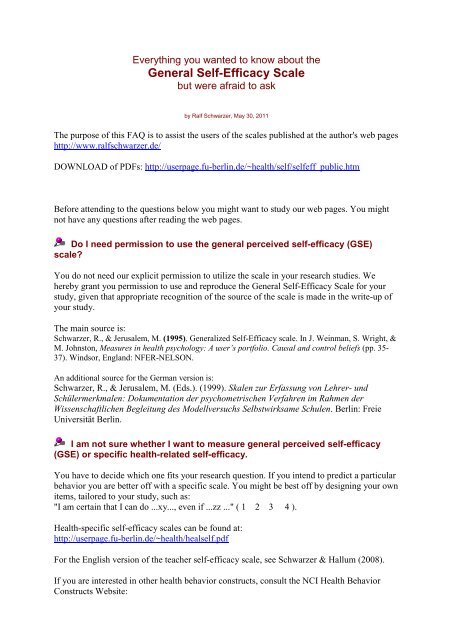

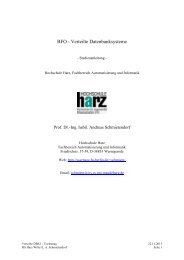
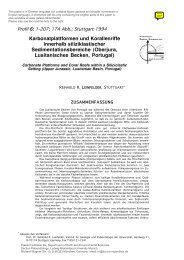


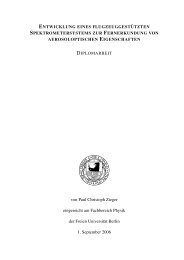
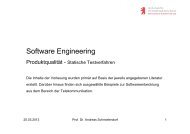
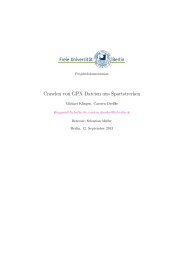
![[UNBEGRENZTE MÖGLICHKEITEN?] - Userpage](https://img.yumpu.com/22343335/1/184x260/unbegrenzte-moglichkeiten-userpage.jpg?quality=85)
